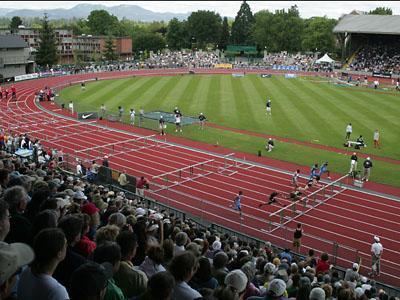Host city Eugene, Oregon, U.S. Main stadium Hayward Field Type Outdoor | Date(s) June 21–July 1 Level Senior | |
 | ||
Events 40 (men: 20; women: 20) | ||
The 2012 United States Olympic Trials for track and field were held at Hayward Field in Eugene, Oregon. Organized by USA Track and Field, the ten-day competition lasted from June 21 until July 1 and served as the national championships in track and field for the United States.
Contents
The results of the event determined qualification for the American Olympic team at the 2012 Summer Olympics, to be held in London. Provided they had achieved the Olympic "A" standard, the top three athletes gained a place on the Olympic team. In the event that a leading athlete did not hold an "A" standard, or an athlete withdrew, the next highest finishing athlete with an "A" standard was selected instead.
The trials for the men's and women's marathon were held January 14 in Houston and the trials for the men's 50 km race walk were held January 22 in Santee, California. The hammer throw competitions were held at the Nike facility in Beaverton, Oregon.
Men's results
Key: ≠ Athlete without "A" standard, not selected.
Notes
a As a result of Nick Ross not having the "A" standard of 2.31 m, fourth-place finisher Jesse Williams was included on the Olympic team as he had an "A" standard. b As a result of Scott Roth not having the "A" standard of 5.72 m, fourth-place finisher Derek Miles was included on the Olympic team as he held an "A" standard. c Brooks was the only individual to throw over the "A" standard of 65.00 m in the competition. However, Rome and Young threw the "A" standard in earlier competitions. d Johnson and Kruger were selected for the Olympic team as both had achieved the "A" standard (78.00 m) from earlier competitions. e Kinsley was included on the Olympic team as he previously held the "A" standard of at least 82.00 m. In addition, fourth-place finisher Sean Furey (77.86 m) and fifth-place finisher Cyrus Hostetler (77.63 m) was included as they held the "A" standard beforehand. f Marks for Eaton were: 10.21 (+0.4 m/s) for 100 metres, 8.23 m (+0.8 m/s) for the long jump, 14.20 m for the shot put, 2.05 m for the high jump, 46.70 for 400 metres, 13.70 for the 110 metres hurdles, 42.81 m for the discus throw, 5.30 m for the pole vault, 58.87 m for the javelin throw, and 4:14.48 for the 1500 metres run. Eaton's performance in the 100 metres and long jump were decathlon bests. He placed first in seven of the ten events. He is now only the second decathlete (after Roman Šebrle) ever to break the 9,000-point barrier. Note Eaton's 8.23 m in the long jump would have tied for second in the men's long jump final.Women's results
Key: ≠ Athlete without "A" standard, not selected.
